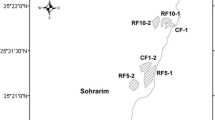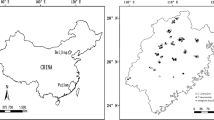Abstract
Forest development in temperate regions is considered to be a global carbon sink. Many studies have examined forest development after harvesting or fire from aboveground (e.g., biomass) or belowground (e.g., soil nutrient) perspectives. However, few studies have explored forest development from both perspectives simultaneously in cool-temperate forests in Japan. In this study, we examined changes over 105 years in both aboveground and belowground components during secondary natural succession. The aboveground biomass increased for 50 years and reached a plateau in a 105-year-old stand. The N mineralization rate increased during succession for 50 years, but showed a decline in the 105-year-old stand due to the decrease in the nitrification rate in late succession. The percent nitrification (i.e., relative contribution of nitrification to N mineralization) decreased significantly with increasing forest stand age. The N mineralization rates had significant relationships with N concentrations of the dominant tree foliage and litter fall and with the amount of litter fall N. Meanwhile, other belowground properties (i.e., soil pH, phenol concentration, soil microbial respiration, and litter mass loss) did not show any significant relationship with forest stand age. This may be because the soil at the study sites was heterogeneous and consisted of Cambisols and Andosols, the latter of which originally has high organic matter content, and thus may have buffered the effect of the aboveground development. These results indicate that belowground N dynamics are more closely associated with aboveground development than other belowground properties in these forests.




Similar content being viewed by others
References
Aber JD, Melillo JM, Nadelhoffer KJ, Pastor J, Boone RD (1991) Factors controlling nitrogen cycling and nitrogen saturation in northern temperate forest ecosystems. Ecol Appl 1:303–315
Anderson JPE, Domsch KH (1978) A physiological method for quantitative measurement of microbial biomass in soils. Soil Biol Biochem 10:215–221
Anderson TH, Domsch KH (1985) Determination of ecophysiological maintenance carbon requirements of soil-microorganisms in a dormant state. Biol Fertil Soils 1:81–89
Anderson KJ, Allen AP, Gillooly JF, Brown JH (2006) Temperature-dependence of biomass accumulation rates during secondary succession. Ecol Lett 9:673–682
Banning NC, Grant CD, Jones DL, Murphy DV (2008) Recovery of soil organic matter, organic matter turnover and nitrogen cycling in a post-mining forest rehabilitation chronosequence. Soil Biol Biochem 40:2021–2031
Batjes NH (1996) Total carbon and nitrogen in the soils of the world. Eur J Soil Sci 47:151–163
Bauhus J, Paré D, Côté L (1998) Effects of tree species, stand age and soil type on soil microbial biomass and its activity in a southern boreal forest. Soil Biol Biochem 30:1077–1089
Bellassen V, Luyssaert S (2014) Carbon sequestration: managing forests in uncertain times. Nature 506:153–155
Bormann FH, Likens GE (1979) Pattern and process in a forested ecosystems. Springer, New York
Canadell JG, Le Quéré C, Raupach MR et al (2007) Contributions to accelerating atmospheric CO2 growth from economic activity, carbon intensity, and efficiency of natural sinks. Proc Natl Acad Sci 104:18866–18870
Chatterjee A, Ingram LJ, Vance GF, Stahl PD (2009) Soil processes and microbial community structures in 45- and 135-year-old lodgepole pine stands. Can J For Res-Rev Can De Rech For 39:2263–2271
Cusack DF, Chadwick OA, Ladefoged T, Vitousek PM (2012) Long-term effects of agriculture on soil carbon pools and carbon chemistry along a Hawaiian environmental gradient. Biogeochemistry 112:229–243
DeLuca TH, Nilsson MC, Zackrisson O (2002) Nitrogen mineralization and phenol accumulation along a fire chronosequence in northern Sweden. Oecologia 133:206–214
Dupouey JL, Dambrine E, Laffite JD, Moares C (2002) Irreversible impact of past land use on forest soils and biodiversity. Ecology 83:2978–2984
Fahey TJ, Woodbury PB, Battles JJ et al (2010) Forest carbon storage: ecology, management, and policy. Front Ecol Environ 8:245–252
Foster D, Swanson F, Aber J et al (2003) The importance of land-use legacies to ecology and conservation. Bioscience 53:77–88
Gower ST, McMurtrie RE, Murty D (1996) Aboveground net primary production decline with stand age: potential causes. Trends Ecol Evol 11:378–382
Haraguchi TF, Uchida M, Shibata Y, Tayasu I (2013) Contributions of detrital subsidies to aboveground spiders during secondary succession, revealed by radiocarbon and stable isotope signatures. Oecologia 171:935–944
Hirobe M, Tokuchi N, Iwatsubo G (1998) Spatial variability of soil nitrogen transformation patterns along a forest slope in a Cryptomeria japonica D. Don plantation. Eur J Soil Biol 34:123–131
Idol TW, Pope PE, Ponder F (2003) N mineralization, nitrification, and N uptake across a 100-year chronosequence of upland hardwood forests. Forest Ecol Manag 176:509–518
Imaya A, Yoshinaga S, Inagaki Y, Tanaka N, Ohta S (2010) Volcanic ash additions control soil carbon accumulation in brown forest soils in Japan. Soil Sci Plant Nutr 56:734–744
Insam H, Domsch KH (1988) Relationship between soil organic carbon and microbial biomass on chronosequences of reclamation sites. Microb Ecol 15:177–188
Insam H, Haselwandter K (1989) Metabolic quotient of the soil microflora in relation to plant succession. Oecologia 79:174–178
Isobe K, Ohte N, Oda T et al (2015) Microbial regulation of nitrogen dynamics along the hillslope of a natural forest. Front Environ Sci 2. doi:10.3389/fenvs.2014.00063
Karsten K, Denis AA, Klaus K, Martin HC (2007) Extraction and characterization of dissolved organic matter. Soil sampling and methods of analysis, 2nd edn. CRC Press, Boca Raton
Kawaguchi H, Yoda K (1986) Carbon-cycling changes during regeneration of a deciduous broadleaf forest after clear-cutting. I. Changes in organic matter and carbon storage. Jpn J Ecol 35:551–563
Keeney DR, Nelson DW (1982) Nitrogen—inorganic forms. In: Page AL, Miller RH, Keeney DR (eds) Methods of soil analysis part 2 American Society of Agronomy. Madison, Wisconsin, pp 643–698
Kira T, Shidei T (1967) Primary production and turnover of organic matter in different forest ecosystems of the Western Pacific. Jpn J Ecol 17:70–87
Lal R (2005) Forest soils and carbon sequestration. Forest Ecol Manag 220:242–258
MacKenzie MD, DeLuca TH, Sala A (2004) Forest structure and organic horizon analysis along a fire chronosequence in the low elevation forests of western Montana. Forest Ecol Manag 203:331–343
MacKenzie MD, DeLuca TH, Sala A (2006) Fire exclusion and nitrogen mineralization in low elevation forests of western Montana. Soil Biol Biochem 38:952–961
Morisada K, Ono K, Kanomata H (2004) Organic carbon stock in forest soils in Japan. Geoderma 119:21–32
Nilsson MC, Wardle DA (2005) Understory vegetation as a forest ecosystem driver: evidence from the northern Swedish boreal forest. Front Ecol Environ 3:421–428
Ogawa H, Kira T (1977) Methods of estimating forest biomass. In: Shidei T, Kira T (eds) Primary productivity of Japanese forests JIBP Synthesis. University of Tokyo Press, Tokyo, pp 15–25
Ogino K (1977) A beech forest in Ashiu—its increment and net production. In: Shidei T, Kira T (eds), Primary productivity of Japanese forest. University of Tokyo Press, Tokyo, pp 172–186
Piatek KB, Allen HL (1999) Nitrogen mineralization in a pine plantation fifteen years after harvesting and site preparation. Soil Sci Soc Am J 63:990–998
Robertson GP, Vitousek PM (1981) Nitrification potentials in primary and secondary succession. Ecology 62:376–386
Ryan MG, Binkley D, Fownes JH (1997) Age-related decline in forest productivity: pattern and process. Adv Ecol Res 27: 213–262
Salamanca EF, Kaneko N, Katagiri S, Nagayama Y (1998) Nutrient dynamics and lignocellulose degradation in decomposing Quercus serrata leaf litter. Ecol Res 13:199–210
Smithwick EAH, Kashian DM, Ryan MG, Turner MG (2009) Long-term nitrogen storage and soil nitrogen availability in post-fire lodgepole pine ecosystems. Ecosystems 12:792–806
Suzuki W (2002) Forest vegetation in and around Ogawa forest reserve in relation to human impact. In: Nakashizuka T, Matsumoto Y (eds) Diversity and interaction in a temperate forest community: Ogawa Forest Reserve of Japan. Springer, Tokyo, pp 27–41
Tateno R, Hishi T, Takeda H (2004) Above- and belowground biomass and net primary production in a cool-temperate deciduous forest in relation to topographical changes in soil nitrogen. For Ecol Manag 193:297–306
Tateno R, Fukushima K, Fujimaki R, Shimamura T, Ohgi M, Arai H, Ohte N, Tokuchi N, Yoshioka T (2009) Biomass allocation and nitrogen limitation in a Cryptomeria japonica plantation chronosequence. J For Res 14:276–285
Thorne JF, Hamburg SP (1985) Nitrification potentials of an old-field chronosequence in Campton, New Hampshire. Ecology 66:1333–1338
Trap J, Bureau F, Vinceslas-Akpa M, Chevalier R, Aubert M (2009) Changes in soil N mineralization and nitrification pathways along a mixed forest chronosequence. For Ecol Manag 258:1284–1292
Vitousek P, Matson P, Cleve K (1989) Nitrogen availability and nitrification during succession: primary, secondary, and old-field seres. Plant Soil 115:229–239
Wardle DA (1993) Changes in the microbial biomass and metabolic quotient during leaf-litter succession in some New Zealand forest and scrubland ecosystems. Funct Ecol 7:346–355
Wardle DA (2002) Communities and ecosystems: Linking the aboveground and belowground components. Princeton University Press, Oxford
Wardle DA, Ghani A (1995) A critique of the microbial metabolic quotient (qCO(2)) as a bioindicator of disturbance and ecosystem development. Soil Biol Biochem 27:1601–1610
White LL, Zak DR, Barnes BV (2004) Biomass accumulation and soil nitrogen availability in an 87-year-old Populus grandidentata chronosequence. For Ecol Manag 191:121–127
Whittaker RH, Bormann FH, Likens GE, Siccama TG (1974) The Hubbard Brook ecosystem study: forest biomass and production. Ecol Monogr 44:233–254
Yan E-R, Wang X-H, Guo M, Zhong Q, Zhou W, Li Y-F (2009) Temporal patterns of net soil N mineralization and nitrification through secondary succession in the subtropical forests of eastern China. Plant Soil 320:181–194
Yoshinaga S, Takahashi M, Aizawa S (2002) Landforms and soil characteristics in Ogawa forest reserve. In: Nakashizuka T, Matsumoto Y (eds) Diversity and interaction in a temperate forest community, ecological studies. Springer, Japan, pp 19–26
Acknowledgments
We would like to thank Makiko Udagawa, Miwa Satoh, Arisa Kobayashi, and Atsuko Tanaka for their assistance. This study was supported by Special Coordination Funds for Promoting Sciences and Technology from MEXT, and partly by a grant-in-aid from the JSPS (25840158).
Author information
Authors and Affiliations
Corresponding author
Electronic supplementary material
Below is the link to the electronic supplementary material.
About this article
Cite this article
Hyodo, F., Haraguchi, T.F., Hirobe, M. et al. Changes in aboveground and belowground properties during secondary natural succession of a cool-temperate forest in Japan. J For Res 21, 170–177 (2016). https://doi.org/10.1007/s10310-016-0526-5
Received:
Accepted:
Published:
Issue Date:
DOI: https://doi.org/10.1007/s10310-016-0526-5




